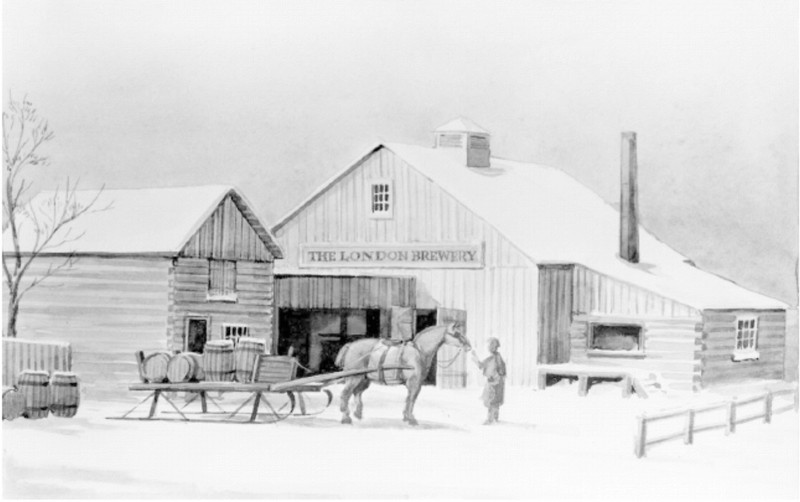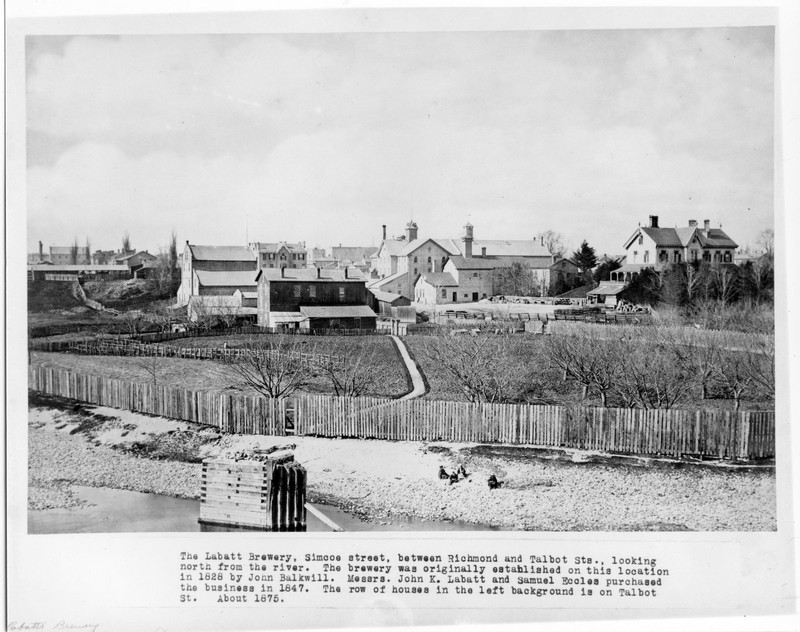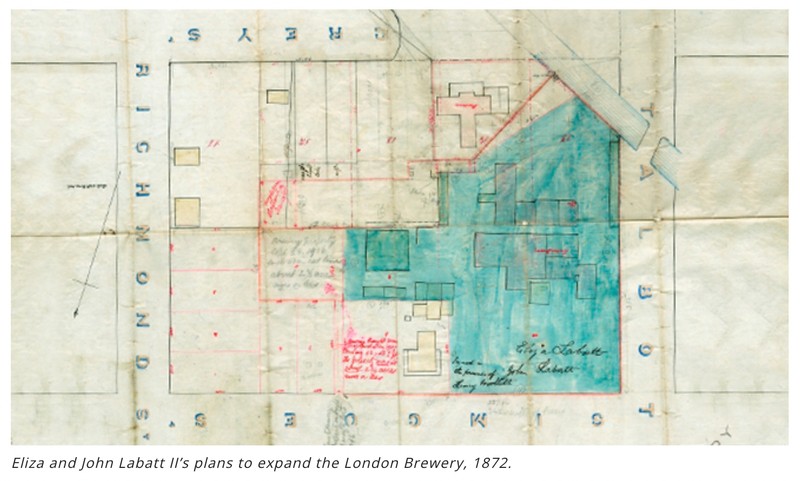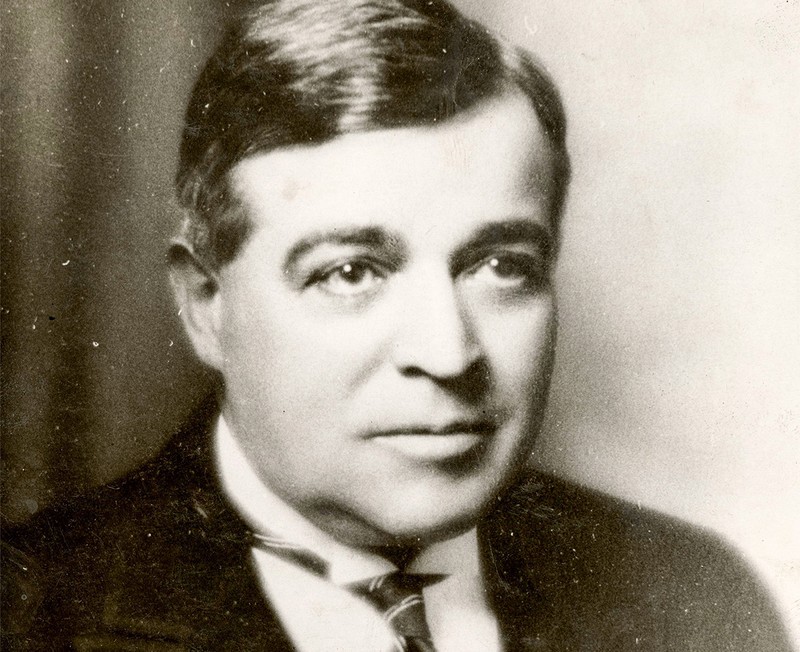The Labatt Brewery and 1934 Kidnapping of John Sackville Labatt
Introduction
Text-to-speech Audio
(We suggest that you stand on the corner of Simcoe and Richmond across from Labatt to get the best view)
Welcome to the Labatt Brewery! Located at 150 Simcoe Street, this massive complex currently spans this entire block. But it was not always this sprawling. The company has had several periods of expansion to reach its current size, particularly between 1861 to 1870. This was before a freak fire broke out in 1874 and burned down the site. John Labatt, the son of the founder John Kinder Labatt, took the opportunity to quickly rebuild and increase the brewing capacity from 6,000 barrels of beer a year to 30,000. It was his efforts to really push the brewing capacity of Labatt that helped the company have its breakthrough and emerge as one of Canada’s top brewers.
Images
Labatt's London Brewery, c. 1847

Glossy Black and white photograph of the area surrounding Labatt Brewery, Simcoe Street viewed from the Thames River

A cardboard mounted glossy print showing, from a distance, what appears to be a fire at the Labatt Brewery

Eliza and John Labatt II’s plans to expand the London Brewery, 1872.

Portrait of John Sackville Labatt

Cover of Susan Goldenberg's book Snatched featuring a picture of John Sackville Labatt

Backstory and Context
Author-Uploaded Audio
Listen to a narration of this entry's description by Public History.
Text-to-speech Audio
Labatt was able to weather Prohibition and the Depression surprisingly well, mostly because of its collaboration with boot-leggers. Edmund Burke was a rough and tumble “problem solver” who was elected to the position of manager and had experience peddling booze south of the boarder. When prohibition went into effect in the United States in 1920, he saw it as an opportunity for Labatt to capitalize on the federal law in Canada that allowed them to still manufacture and export booze. During this period, there was very little police presence along the border and the fines for getting caught were very little. The tradeoff would be the saving of the Labatt company.
Consequently, Labatt went into the 1930s in reasonably good shape for a major company. Prohibition ended in Ontario in 1927, though it was followed shortly by the market crash of 1929. By 1934, Labatt was on an upswing in profit since the onset of the Depression. They had made 495,044 dollars by the end of the year which almost doubled their profits from the year previous. But their success also bred resentment. The company’s steadiness during the economic turmoil that was the late 1920s and 1930s led to several of its major players becoming targets.
John Sackville Labatt, the eldest son of John Labatt and grandson of John Kinder Labatt, had been warned as early as 1930 to beware of potential kidnappers. There had been a close call in the summer of 1933, but it was on August 14th, 1934, while driving back from a cottage on Lake Huron to a meeting at this site, that Canada’s highest profile kidnapping occurred.
Kidnapping was not uncommon during the height of the Depression. The unemployment rate had remained incredibly high since the market crash and Brewery owners were popular targets. Two other London liquor men had already been kidnapped and held for ransom before the case of John Sackville Labatt, Sam Low and Charles Burns, but John Sackville was one of the richest brewers in Canada.
Which is why Michael McCardell, his kidnapper, asked for 150,000 dollars.
McCardell was a fledgling gang leader and while he had been in the underworld for some time, he and his accomplices had never participated in kidnapping before. They held John Sackville Labatt for three days at a cabin near Lake Muskoka. They stripped him, blindfolded him, and used a dog leash to chain his right wrist to the bed. But they also showed him an unusual amount of care during this period. Strangely, McCardell seemed to have no issue with showing Labatt his face and always made sure to give a daily shave, keep him well fed, and chatted with him.
Meanwhile, Hugh Labatt had received the ransom note which resulted in the quick mobilization of Major-General Mewburn, Major-General Victor Williams, Brigadier-General D.C. Draper, and the Toronto City Police. The press had gotten hold of the news of the kidnapping and ran a story on the night of the 14th. It became so widespread that the New York Times’ building in Times Square flashed a bulletin on the topic in five-foot tall letters. The Toronto Star, the London Free Press, and the Globe were all regularly running headlines on the topic. The police dragnet was also tightened significantly.
All of this commotion caused McCardell and his lackies to panic. Instead of a simple kidnapping and ransom that would make him rich, he had touched on a nerve in Canadian society. In an attempt to smooth things over McCardell extracted a promise out of Labatt that he would release him if he promised to pay him 25,000 dollars after his release. On 12:30 am on Friday, August 17th, McCardell dropped Labatt off at the corner of Vaughan Road and St Clair Avenue in Toronto. Eventually, the three kidnappers were arrested and sentenced to imprisonment for 15 years while the fourth died in the United States.
The kidnapping and subsequent two-year trial actually helped promote the popularity of the Labatt brand. In many ways, it acted as a metaphor for the resiliency of the Labatt company being the only surviving London-based brewery in this period. Their success was that the brewery now made one in five beers consumed in the province. In many ways, the case of the kidnapping amplified London’s mythos as a beer city.
Sources
Bellamy, Matthew J. Brewed in the North: A History of Labatt's. Montreal: McGill-Queen's University Press, 2019. Accessed October 28, 2021. ProQuest Ebook Central.
Bellamy, Matthew J. “The Birth of a Brewery.” Labatt: A Closer Look. https://labattheritage.lib.uwo.ca/closer-look/the-birth-of-a-brewery.
Bellamy, Matthew J. “Labatt Timeline.” Labatt: A Closer Look. https://labattheritage.lib.uwo.ca/timeline/full-history/1911-1949.
Canadian Coin News. “On This Day: John Sackville Labatt abducted at gunpoint.” August 14, 2021. https://canadiancoinnews.com/otd-john-sackville-labatt-abducted-at-gunpoint/.
Goldenberg, Susan. Snatched!: The Peculiar Kidnapping of Beer Tycoon John Labatt. Dundurn Group, 2004.
Taken from Matthew Bellamy's Brewed in the North: A History of Labatt's.
Ivey Family London Room, London Public Library, London, Ontario, Canada
Ivey Family London Room, London Public Library, London, Ontario, Canada
Taken from Matthew Bellamy's "The Birth of a Brewery."
UWO, Archives and Special Collections
Susan Goldenberg's Snatched
